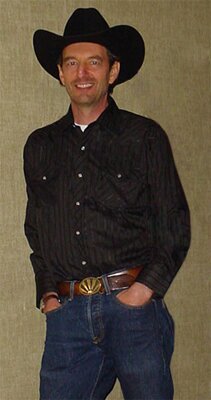Welcome to the “My Place” page
 My name is Scott My name is Scott
I run the Rope and Wire website.
My original idea for this page was to give those living in the country the opportunity to tell others about the things that made their farm or ranch so special.
Well, I’ve come to the conclusion that either no one likes to brag or no one lives on a farm or a ranch. Whatever the case, no one submitted an article so I felt it was high time to try something different.
So for now this will be literally “My Place.” I’ll use this page to post a western blog or short articles. They will either be mine, or possibly one from a contributing R&W community member.
The theme will remain Western but the content will change weekly, or there about.
If you click on any of the links to past blog's, you can return to this page by clicking on the My Place button across from my picture.
I hope you enjoy it but if not, might I suggest you “stroll the grounds.” Read a story or watch a movie.
Thanks for visiting.
Scott
Wild Horses in America
Living in the West you tend to hear a lot about wild horses from both sides of the issue. Ranchers, wild horse enthusiasts and the BLM (Bureau of Land Management) all have concerns about the wild horse and they don’t always agree on how to handle the wild horse issue.
Let’s start at the beginning. How did we end up with wild horses anyhow?
It seems to have started several hundred years back when Spain began to establish missions in North America. The Native Americans in the area often raided those missions for the horses.
Some escaped.
In 1680 the Native Americans successfully resisted the domination of Spain in what is known as the “Pueblo Revolt”. The revolt provided the Pueblo Indians with several thousand horses. With these horses they started breeding larger herds selling many of them to other Native American tribes.
Some escaped.
By the mid 1700’s the Native American horse culture was well established.
At about this same time the Western short grass prairies were supporting large herds of bison. It was a natural choice for horses to join the bison in these areas.
By the mid 1800’s large herds of horses were turned loose on the open range to pasture. They were an important resource to ranchers. It was a way to provide them with new ranch stock, gathering them when they were needed.
Those who fell upon hard times and couldn’t afford to keep their stock abandoned them on the open plains. These included Draft, Carriage and saddle horses. Left to fend for themselves, these horses became what we refer to today as “wild” horses.
Eventually, as the white man migrated further West, the great bison herds were all but wiped out. Cattle and sheep were eventually introduced to the short grass prairie. So with what was left of the bison plus the cattle, sheep and horses all grazing in the same basic area, overgrazing slowly and permanently altered the short grass prairies. So much so, that over the years, the natural selection process has produced wild horses that are not only strong and sure-footed. They are also sound-minded and intelligent. They function well within a natural social unit and once they overcome their fear of people, they can be trained to perform a variety of tasks.
Managing wild horses.
Up until the 1970’s, wild horses were seen as having little value and were routinely rounded up and slaughtered for the pet food market.
During this time a successful public awareness campaign was under way. In 1971 the U. S. Congress passed the “Wild and Free-Roaming Horses and Burros Act” which required the protection and management of wild horses and burros. The BLM was put in charge of these wild herds. They are now under the protection and management of our Federal Government.
There are an estimated fifty thousand wild horses on Western public lands these days. One way the BLM manages the wild horse and burro population is by holding an annual roundup putting wild horses up for public adoption to whoever is willing and able to provide them with good homes.
Unfortunately, the Federal protection only covers wild horses, and not all of them at that. Thousands of domestic horses are still slaughtered in this country or shipped to foreign slaughterhouses each year. These are mainly riding horses and former racehorses. But my understanding is that some wild horses still manage to get caught on the wrong side of the fence, so to speak.
Horses played a major roll in the history of our country. Before the automobile, they were our main mode of transportation. They pulled the plows that cultivated our land and they carried the soldiers who fought so bravely for it. Many horses died alongside the soldiers they carried. Horses were a huge part of the American culture for both the white man and the Native American. From the East coast to the West. They played a big part in the Westward expansion of this country. They are still a big part of our culture even to this day. Many Western ranchers are very much dependant on horses as part of there day to day operations.
There was a time in our history when a horse was so important, a man would pay with his life for stealing another mans horse. And now we slaughter them for dog food. In my opinion, to send even one of these magnificent animals to the slaughterhouse is wrong. It may not be a hangin’ offence, but it’s definitely criminal.
|